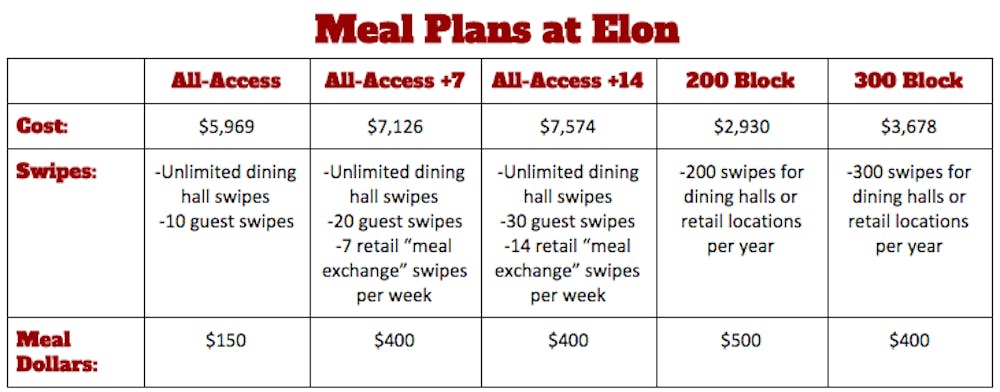More than half of Elon University’s students are on a meal plan. There are five meal plans available to students, with a choice between all-access or block.
While block plans provide a set number of swipes for the year, all-access meal plans allow for unlimited swipes to the dining halls.
All freshman and sophomore students living in residence halls are required to have an all-access meal plan.
Director of Auxiliary Services, Carrie Ryan, says this is to keep Elon a "residential campus."
“We want students those first two years to live in our residence halls, and we want them engaging in our dining facilities,” Ryan said. “Having those interactions, that social interaction, as well as the community building feel.”
The all-access plan can be upgraded with seven or fourteen extra swipes a week to use at retail locations on campus. Upperclassmen living in apartments on or off campus have the option of choosing a block plan, with either three hundred or two hundred swipes for the year.
In addition to block swipes, these plans also include a set number of meal dollars for the year. The 200 block plan gives students 500 meal dollars to be used like a debit card at dining halls or retail locations.
The 200 block plan is the least cost-effective of the two block plans, as well as the least popular meal plan among students, according to Ryan. Each swipe on the 200 block plan is worth twelve dollars and fifteen cents.
Breaking down the costs

A break down of meal plan costs.
To break down the cost of a swipe, let's look at one of Elon's retail locations. A typical lunch at Acorn Coffee Shop, one of Elon’s retail dining locations, is usually a sandwich. One block swipe at Acorn comes with a side and a drink. Looking at the menu, a sandwich costs $4.99, chips cost $1.09 and a fountain drink costs $1.79.
That comes to a total of $7.87, wasting $4.28.
For breakfast at Acorn, a student might choose a bagel and a coffee. Bagels cost $1.59 and a small coffee costs $1.95. This only comes to $3.54, wasting a total of $8.61. Because using a swipe would waste nearly nine dollars, it would be more cost-effective to use meal dollars instead.
Ryan says these costs aren’t decided by dining services.
“When the university looks at tuition, meal plans, room and board, all those pieces are joined and ultimately decided on by the Board of Trustees,” Ryan said.
These decisions are now being reconsidered again. Ryan says there are more changes in store for meal plans.
“We’re starting the process of revisiting what new meal plans will be for the university,” Ryan said. “All-access was the new thing back then, so it’s kinda hard to beat all-access, but we’re working hard to figure out what that looks like.”
Ryan says an upgrade to the all-access meal plan is currently in the works.

